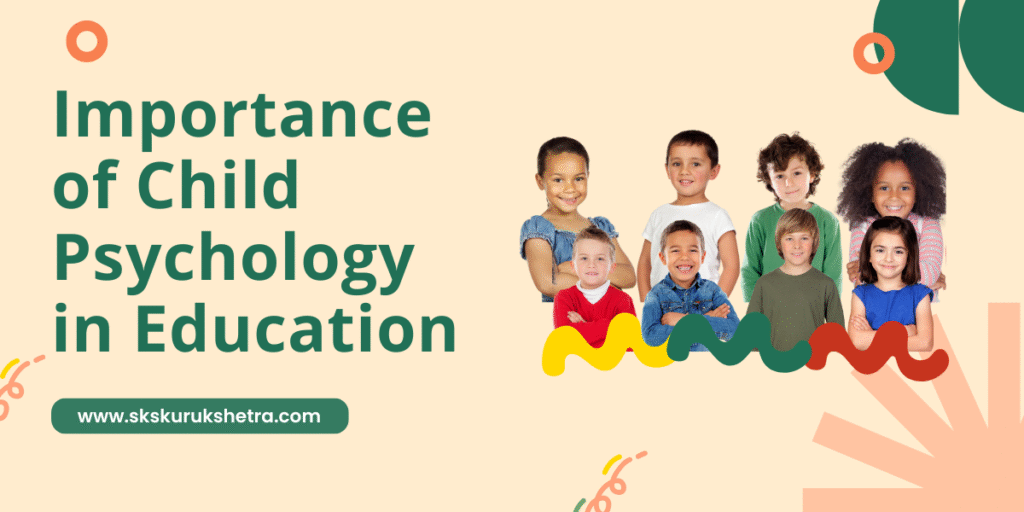Understanding children—how they think, learn, feel, and grow—is central to effective education.
Child psychology gives teachers, parents, school leaders, and policymakers the knowledge and tools to create learning environments that are safe, motivating, inclusive, and growth-focused.
This article explains: Importance of Child Psychology in Education, why child psychology matters in education, how its principles apply in classrooms, and practical steps schools and teachers can take to put these ideas into practice.
By the end you’ll have a complete, easy-to-follow guide that covers theory, practice, benefits, challenges, and FAQs.
Why child psychology matters: Importance of Child Psychology in Education
Child psychology studies the mental, emotional, social, and cognitive development of children from infancy through adolescence. Its importance for education lies in these core ideas:
- Learning is developmentally grounded. Children of different ages think and learn in different ways. Teaching that matches developmental stages is more effective.
- Emotion and cognition are linked. A child who feels safe, respected, and motivated learns better.
- Individual differences matter. Each child has unique strengths, learning styles, temperament, and background. Effective education recognizes and responds to those differences.
- Early experiences shape long-term outcomes. Classroom experiences, teacher-student relationships, and early interventions can change the trajectory of a child’s academic and social life.
When educators understand developmental milestones, behavior causes, and emotional needs, they can design lessons, spaces, and school policies that help every child thrive.
Must Read: How to Start Investing as a Student: Your Complete Guide to Building Wealth Early
Core concepts from child psychology every educator should know
1. Developmental stages
Familiar frameworks (Piaget, Erikson, Vygotsky) describe how thinking, identity, and social skills change with age. Key takeaways:
- Early childhood (0–6 years): Learning through play, sensory experiences, and imitation. Language development and basic social skills rapidly expand.
- Middle childhood (6–12 years): Logical thinking grows; children become better at concrete problem-solving and peer relationships become more important.
- Adolescence (12–18 years): Abstract thinking, identity formation, and emotional complexity increase. Peer influence and self-concept shape learning behaviors.
2. Zone of Proximal Development (ZPD)
Vygotsky’s ZPD shows that children learn best when tasks are just beyond their independent ability but achievable with guidance. Scaffolding (teacher support) helps move skills from assisted to independent.
3. Attachment and relationships
Secure relationships with caregivers and teachers build a sense of safety and motivation. Securely attached children are more likely to take academic risks and regulate emotions.
4. Motivation and self-regulation
Understanding intrinsic vs. extrinsic motivation helps teachers design tasks that spark curiosity and sustained effort. Teaching self-regulation—goal setting, impulse control, and monitoring—boosts long-term learning.
5. Learning differences and neurodiversity
Children may have dyslexia, ADHD, autism spectrum differences, or other learning profiles. Knowing how these affect learning helps educators adapt instruction rather than label or lower expectations.
6. Social and emotional learning (SEL)
SEL teaches skills like empathy, teamwork, emotion management, and responsible decision-making. These skills are academically linked: students with strong SEL perform better and have fewer behavioral problems.
How child psychology improves classroom teaching
Design lessons that match development
- Use play-based and sensory activities for younger learners.
- Offer concrete examples and step-by-step problems for middle childhood.
- Provide discussion-based, project-based, and abstract tasks for adolescents.
Scaffold learning
- Break complex tasks into smaller steps.
- Model strategies (thinking aloud).
- Provide prompts and gradually reduce support as competence grows.
Build positive relationships
- Learn each child’s name, strengths, and interests.
- Offer consistent warmth and clear boundaries.
- Use positive reinforcement to encourage constructive behavior.
Teach self-regulation and executive skills
- Introduce routines, checklists, and visual schedules.
- Teach time management and planning explicitly.
- Use brief mindfulness or breathing activities to help with focus.
Differentiate instruction
- Provide multiple ways to present content (visual, auditory, kinesthetic).
- Offer tiered tasks with different levels of support.
- Use formative assessments to tailor future lessons.
Promote active learning
- Ask open-ended questions.
- Use collaborative group work.
- Include hands-on experiments, role-play, and projects.
Classroom strategies grounded in child psychology
1. Positive Behaviour Supports
Instead of punishment-focused discipline, positive behaviour supports reinforce desired behavior through praise, incentives, and consistent routines.
2. Universal Design for Learning (UDL)
UDL provides multiple means of engagement, representation, and expression so all students can access the curriculum.
3. Play and inquiry-based learning
Young children learn language, social skills, and problem-solving through guided play. Even older students benefit from inquiry projects that feed curiosity.
4. Formative assessment and feedback
Frequent low-stakes checks of understanding help teachers adjust instruction. Feedback should be specific, actionable, and timely.
5. Peer learning and cooperative groups
Peer tutoring and collaborative tasks tap social motivation and allow students to internalize learning by teaching others.
6. Classroom environment and sensory needs
Lighting, noise levels, seating arrangements, and sensory corners can all affect concentration. Providing calming spaces or fidget tools can help many learners.
Role of teachers and school staff
Teacher as psychologist-in-practice
Teachers observe behavior, interpret causes, and respond with instructional and pastoral strategies. Basic training in child development helps teachers respond effectively.
School counselors and psychologists
These professionals assess learning or emotional difficulties, design interventions, and collaborate with teachers and families.
Continuing professional development
Workshops on trauma-informed teaching, SEL, neurodiversity, and behavior management improve classroom outcomes.
Working with parents and families
Communication and partnership
- Share strengths and growth areas regularly.
- Use positive communication as the default.
- Give parents concrete strategies they can use at home.
Cultural sensitivity
Respect family backgrounds and values. Learning is influenced by culture; culturally responsive teaching improves connection and relevance.
Early intervention
When parents and teachers work together to address delays or behavioral concerns early, outcomes improve drastically.
Mental health, trauma, and resilience
Trauma-informed education
Children exposed to trauma may have attention, memory, or emotional regulation difficulties. Trauma-informed practices emphasize safety, predictability, and relationships.
Promoting resilience
Teach problem-solving, build support networks, and model coping strategies. Resilience can buffer children from negative outcomes even when risk factors are present.
Identifying signs
Know common signs of distress: withdrawal, sudden behavior changes, declining grades, frequent somatic complaints. Early referral to counselors is key.
Assessment and measurement from a child psychology lens
Beyond standardized tests
Standardized tests measure certain skills but miss social, emotional, creative, and practical intelligence. Use a mix:
- Formative assessments: quick checks for learning.
- Performance tasks: projects and portfolios that show deep understanding.
- Observational measures: teacher notes on behavior, participation, and interactions.
- Psychological assessments: when learning difficulties or mental health issues are suspected.
Ethical use of assessment
Assessments should be fair, culturally appropriate, and used to support learning—not to label or exclude.
Designing curriculum with child psychology in mind
Developmentally appropriate sequencing
Start with concrete concepts and move to abstract. Build skills progressively.
Integrating SEL and life skills
Embed emotion management, empathy, and decision-making across subjects rather than treating them as separate “add-ons.”
Active and experiential learning
Project-based learning, labs, field trips, and real-world tasks help children connect knowledge to life.
Technology, screens, and child development
Smart use of educational technology
Technology can personalize learning and provide multisensory experiences. Use short, focused activities and balance screen time with hands-on work.
Risks to monitor
Excessive passive screen use can reduce attention and social interaction. Choose interactive, educational content and set clear boundaries.
Special education and inclusion
Inclusive classrooms
Inclusion means supporting students with diverse needs in general classrooms with appropriate supports—assistive technology, peer buddies, differentiated tasks, and specialist consultation.
Individualized Education Plans (IEPs)
IEPs set measurable goals, specify supports, and involve parents and teachers. They follow child psychology principles by tailoring learning to the child.
Teacher mental health and burnout
Teacher well-being affects students. Schools should:
- Provide professional support and counseling.
- Encourage collaborative planning (reducing isolation).
- Offer training in stress management and time-saving pedagogies.
When teachers are supported, classrooms become more positive and effective.
Policy and system-level implications
Early childhood investment
High-quality preschool programs based on developmental science produce lifelong benefits—better school performance, reduced behavioral problems, and higher graduation rates.
Teacher education reform
Pre-service and in-service teacher training should include child development, mental health awareness, and practical classroom strategies rooted in psychology.
School climate and safety
Policies promoting anti-bullying, inclusion, mental health resources, and restorative practices create environments where children can learn and grow.
Real-world examples
- Case A — Scaffolding leads to success: A 3rd-grade student struggles with multi-step math problems. The teacher models problem-solving steps aloud, provides guided practice with prompts, and gradually reduces help. The student gains confidence and independent problem-solving skills.
- Case B — Trauma-informed change: A school notices several students with behavior outbursts. Staff are trained in trauma-informed approaches. Routines are made predictable, a quiet ‘calm corner’ is added, and counselors are available. Over months, disciplinary incidents drop and attendance improves.
- Case C — Inclusive reading program: A class includes a child with dyslexia. Using multisensory reading methods, audiobooks, and extra time, the child improves reading fluency and participates more in class discussions.
Measuring success: outcomes to track
- Academic growth (not just test scores)
- Attendance and classroom engagement
- Social skills and peer relationships
- Emotional regulation and resilience indicators
- Teacher and parent satisfaction
- Reduction in disciplinary incidents
Collect both quantitative and qualitative data (portfolios, interviews, observations) for a full picture.
Common challenges and practical solutions
Challenge: Large class sizes
Solution: Use peer tutoring, cooperative learning, and small group rotations to provide attention to diverse learners.
Challenge: Limited training in child psychology
Solution: Short modular workshops, peer mentoring, and online resources focused on practical classroom strategies.
Challenge: Stigma around mental health
Solution: Normalize conversations, embed SEL in daily lessons, and create safe spaces for disclosure and support.
Challenge: Resource constraints
Solution: Prioritize high-impact, low-cost strategies: consistent routines, targeted praise, formative assessments, and community volunteer programs.
Must Read: How to Become a Confident Teacher – A Detailed Guide
How schools can start integrating child psychology today
- Train teachers in core developmental principles.
- Add short daily SEL activities (5–10 minutes).
- Use formative assessments weekly to personalise instruction.
- Create a calm corner or sensory space.
- Set up regular teacher-parent communication routines.
- Partner with local mental health professionals for referrals and training.
- Build peer mentoring and cooperative learning into lesson plans.
Final thoughts
Child psychology is not a separate subject for schools—it is the foundation of good teaching.
When schools and teachers use developmental knowledge to shape curriculum, classroom interactions, and school policies, children benefit academically, socially, and emotionally.
Small, consistent changes—like predictable routines, scaffolding, SEL, and inclusive teaching—yield big results over time. Investing in teacher training, early intervention, and a supportive school climate creates not only better learners but more resilient and confident human beings.
If you’re an educator, school leader, or parent: start small, observe closely, and build systems that put the child’s development at the center of education. The result will be classrooms where learning is joyful, fair, and effective for every child.
FAQs
Q: What is child psychology and why is it important for teachers?
A: Child psychology studies how children develop cognitively, emotionally, and socially. Teachers who understand it can match instruction to development, create supportive environments, and identify when extra help is needed.
Q: At what age should SEL programs start?
A: SEL can start in early childhood with simple activities (sharing, naming emotions) and continue in age-appropriate ways through adolescence.
Q: How does child psychology help children with learning difficulties?
A: It helps identify underlying cognitive or emotional causes and informs tailored teaching strategies, accommodations, and timely interventions.
Q: Can technology support child development?
A: Yes—when used intentionally. Interactive, guided educational tools can support personalized learning, but balance with hands-on activities is essential.
Q: What should teachers do if they suspect trauma or serious mental health issues?
A: Follow school protocols: ensure safety, provide immediate support, involve counselors, and communicate with parents while maintaining confidentiality and sensitivity.

